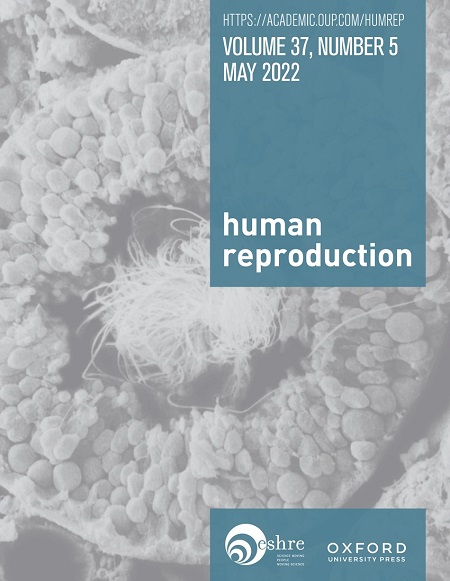Functional, patient-derived 3D tri-culture models of the uterine wall in a microfluidic array
IF 6
1区 医学
Q1 OBSTETRICS & GYNECOLOGY
引用次数: 0
Abstract
STUDY QUESTION Can a functional in vitro model, containing the main cellular components of the uterine wall, be generated from cells derived from patient tissues? SUMMARY ANSWER We present a three-dimensional (3D) physiologically relevant, organ-on-a-chip model of the uterine wall containing primary endometrial and myometrial cellular participants, generated from human uterine tissue. WHAT IS KNOWN ALREADY As a highly dynamic reproductive organ, the human uterus plays fundamental physiological roles in menstruation and childbirth. The endometrial–myometrial junction (EMJ) defines the interface between the inner mucosal layer (endometrium) and outer smooth muscle zone (myometrium) that comprises the uterine wall. The EMJ is implicit in several uterine pathologies of unknown aetiology, including adenomyosis and abnormally invasive placenta; however, despite this, no patient-derived in vitro models of the uterine wall containing all EMJ participants currently exist. STUDY DESIGN, SIZE, DURATION We employed microfluidic technology to characterize multiple miniaturized models of the uterine wall. Protocols were tested that included variations in the seeding order of endometrial and myometrial fractions, and the addition of a low viscosity extracellular matrix to influence cell behaviour. Ultimately, functional hormone responses of patient-derived uterine wall models were assessed. PARTICIPANTS/MATERIALS, SETTING, METHODS Endometrial (n = 9) and myometrial biopsies (n = 4) were enzymatically dissociated to create epithelial, stromal and myometrial cellular fractions. Cell suspensions were seeded into non-adhesive poly(dimethylsiloxane) microfluidic devices containing 5 × 5 microwell arrays. The fate of individual cell types was monitored in real-time using fluorescent tracers, and cell phenotype was characterized by immunocytochemistry. Model functionality was assessed by measuring Ca2+ responses to agonist stimulation, and both insulin-like growth factor binding protein 1 (IGFBP-1) and osteopontin secretion in response to hormone stimulation. MAIN RESULTS AND THE ROLE OF CHANCE When subjected to microfluidic culture in isolation, endometrial stromal cells and smooth muscle myocytes formed compact spheroids, whilst epithelial cells produced diffuse aggregates. Tri-cultures were established by sequential seeding of individual or combined cell fractions at various ratios. Regardless of the protocol, epithelial cells localized to the outer periphery of tri-culture spheroids, which varied in morphology across the protocols. Incorporation of 5% [v/v] Matrigel® improved the reproducibility of 3D aggregates which exhibited robust self-assembly of a stromal/smooth muscle core encased in epithelium. Exposure of tri-cultures to oestradiol, medroxyprogesterone acetate and cyclic adenosine monophosphate (cAMP) increased secretion of IGFBP-1, which indicates stromal decidualization, and enhanced epithelial cell osteopontin secretion. Stimulation with endothelin-1 induced Ca2+ signalling in myocytes. LIMITATIONS, REASONS FOR CAUTION Endometrial and myometrial tissue was collected from relatively few donors. Myometrial tissue was collected from pregnant donors, which may have influenced the myocyte phenotype. Furthermore, endometrial tissue sampling was from women not having a hysterectomy, thus may not include the deeper basalis region, which may limit the physiological mimicry of the final models. WIDER IMPLICATIONS OF THE FINDINGS Our novel approach to modelling the uterine wall in 3D captures all of the main cell types in a medium-throughput system, enabling the screening of hundreds of cultures in parallel from a single biopsy. This system shows great promise for examining the cellular interplay between physiological cues and EMJ pathologies, such as the impact of uterine peristalsis and cyclical hormones on the pathogenesis of adenomyosis. STUDY FUNDING/COMPETING INTEREST(S) C.B. was supported by an Organ-on-a-Chip Technologies Network Pump Priming Project grant. C.J.H. was supported by a Wellbeing of Women project grant (RG2137), SRI/Bayer and Wellcome Trust IFFS3. D.K.H. was supported by a Wellbeing of Women project grant (RG2137) and MRC clinical research training fellowship (MR/V007238/1). M.Z. is Director and Co-Founder of ScreenIn3D Limited. The other authors declare no conflict of interest. TRIAL REGISTRATION NUMBER N/A.微流控阵列中的功能性、源自患者的子宫壁三维培养模型
研究问题 从患者组织中提取的细胞能否生成包含子宫壁主要细胞成分的功能性体外模型?摘要:我们介绍了一种三维(3D)生理相关的子宫壁片上器官模型,该模型包含原始子宫内膜和子宫肌细胞参与者,由人体子宫组织生成。已知信息 作为一个高度动态的生殖器官,人类子宫在月经和分娩过程中发挥着基本的生理作用。子宫内膜-子宫肌层交界处(EMJ)定义了构成子宫壁的内层粘膜(子宫内膜)和外层平滑肌区(子宫肌层)之间的界面。EMJ隐含在几种病因不明的子宫病变中,包括子宫腺肌症和异常侵袭性胎盘;然而,尽管如此,目前还没有包含所有EMJ参与者的患者子宫壁体外模型。研究设计、规模、持续时间 我们采用微流控技术来鉴定多个微型子宫壁模型。测试方案包括改变子宫内膜和子宫肌层的播种顺序,以及添加低粘度细胞外基质以影响细胞行为。最终,对患者子宫壁模型的功能性激素反应进行了评估。参与者/材料、设置、方法 对子宫内膜(n = 9)和子宫肌层活检组织(n = 4)进行酶解,生成上皮细胞、基质细胞和子宫肌层细胞部分。细胞悬浮液被播种到含有 5 × 5 微孔阵列的非粘性聚(二甲基硅氧烷)微流体装置中。使用荧光示踪剂实时监测单个细胞类型的命运,并通过免疫细胞化学鉴定细胞表型。通过测量 Ca2+ 对激动剂刺激的反应,以及胰岛素样生长因子结合蛋白 1 (IGFBP-1) 和骨化素分泌对激素刺激的反应,评估了模型的功能。主要结果和偶然性的作用 在单独进行微流控培养时,子宫内膜基质细胞和平滑肌肌细胞形成紧密的球状,而上皮细胞则产生弥散的聚集。通过以不同比例连续播种单个或组合细胞组分,建立了三培养物。无论采用哪种方案,上皮细胞都定位于三培养球的外周,不同方案的上皮细胞形态各异。5%[v/v]Matrigel®的加入提高了三维聚集体的可重复性,三维聚集体表现出上皮包裹基质/平滑肌核心的强大自组装能力。将三层培养物暴露于雌二醇、醋酸甲羟孕酮和环磷酸腺苷(cAMP)中可增加 IGFBP-1 的分泌(表明基质蜕膜化),并增强上皮细胞骨化素的分泌。内皮素-1 的刺激可诱导肌细胞中的 Ca2+ 信号。局限性、注意事项 子宫内膜和子宫肌组织是从相对较少的供体中采集的。子宫肌层组织取自怀孕的供体,这可能会影响肌细胞的表型。此外,子宫内膜组织取自未切除子宫的妇女,因此可能不包括较深的基底区域,这可能会限制最终模型的生理模拟。研究结果的广泛影响 我们的三维子宫壁建模新方法能在中等通量系统中捕获所有主要细胞类型,从而能从单个活检组织中同时筛选出数百个培养物。该系统为研究生理线索与子宫内膜异位症病理之间的细胞相互作用(如子宫蠕动和周期性荷尔蒙对子宫腺肌症发病机制的影响)提供了巨大前景。研究经费/合作利益 C.B.获得了器官芯片技术网络泵启动项目的资助。C.J.H.获得了妇女福祉项目基金(RG2137)、SRI/拜耳公司和惠康基金会IFFS3的资助。D.K.H.获得了Wellbeing of Women项目基金(RG2137)和MRC临床研究培训奖学金(MR/V007238/1)的资助。M.Z. 是 ScreenIn3D 有限公司的董事和联合创始人。其他作者声明无利益冲突。试验注册号为 n/a。
本文章由计算机程序翻译,如有差异,请以英文原文为准。
求助全文
约1分钟内获得全文
求助全文
来源期刊

Human reproduction
医学-妇产科学
CiteScore
10.90
自引率
6.60%
发文量
1369
审稿时长
1 months
期刊介绍:
Human Reproduction features full-length, peer-reviewed papers reporting original research, concise clinical case reports, as well as opinions and debates on topical issues.
Papers published cover the clinical science and medical aspects of reproductive physiology, pathology and endocrinology; including andrology, gonad function, gametogenesis, fertilization, embryo development, implantation, early pregnancy, genetics, genetic diagnosis, oncology, infectious disease, surgery, contraception, infertility treatment, psychology, ethics and social issues.
 求助内容:
求助内容: 应助结果提醒方式:
应助结果提醒方式:


